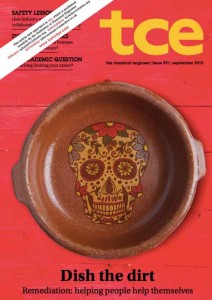
The best way to help communities clean up toxic sites is to advise and encourage, say Andrew McCartor, Bret Ericson and Sandra Gualtero.
In the September issue of TCE magazine (The Chemical Engineer), the three Pure Earth program directors wrote about their experiences shepherding remediation projects in three very different parts of the world —Azerbaijan, Vietnam and Mexico.
The projects illustrate how communities can help themselves, with a little support, and how initial investments in cleanups can replicate and spread. Read the full story – Dish The Dirt – Remediation: Helping People Help Themselves.
Getting Arrested In Azerbaijan
Andrew McCartor had been in Azerbaijan less than 24 hours when he found himself in jail. Along with a local contact, he had been rounded up for taking pictures of an abandoned industrial estate in the city of Sumgayit – the site of a beach contaminated with PCBs, and a former hub of Soviet chemical production. The city had bristled at being listed in one of Pure Earth’s reports as one of the world’s worst polluted places. Now, it was time to clean up, and we were there to help. Read more about Drew’s adventures in TCE magazine, or learn about the beach cleanup.
A Toxic “Craft Village” In Vietnam
During the Vietnam War, a U.S bomber crashed near a rural North Vietnamese village. By chance, someone in the village had experience in smelting metals, and saw the plane’s mangled parts as an opportunity. He dismantled it, carried the pieces home, and melted them down to create aluminium ingots for resale. The practice caught on and helped to transform hundreds of Vietnamese villages into metal recycling factories, each specialising in a particular metal or product. These villages are misleadingly referred to as ‘craft villages’. Backyard smelting takes place in many villages with little personal protective equipment and few or no emissions controls. Children play next to furnaces firing at 1,000 degrees C.
In the case of Dong Mai, the metal being recycled was lead – an acute neurotoxin. Bret Ericson calls Dong Mai “the site of the most severe lead poisoning epidemic I have ever witnessed.” Read more in TCE magazine, or watch a video about our work in Dong Mai.
A Late Night E-Mail From Mexico
In June of 2015, Sandra Gualtero received a late-night email labelled “URGENT.” It was from a nurse in the Mexican state of Morelos who was conducting screenings of lead levels in the blood of newborns as part of a pilot project. The nurse had just discovered a baby witha blood-lead concentration seven times above the level of concern. Sandra soon discovered that the baby (and mother) in Morelos had been poisoned by leaded pottery.
When the average person pictures chemical pollution, they might conjure billowing smoke stacks or toxic green slime that turns turtles into mutant ninjas. Few would picture a woman sitting behind a pottery wheel making ceramics. In Mexico, however, that image is quite relevant to the country’s pollution story. Read more in TCE magazine, or learn more about our Barro Aprobado project.





